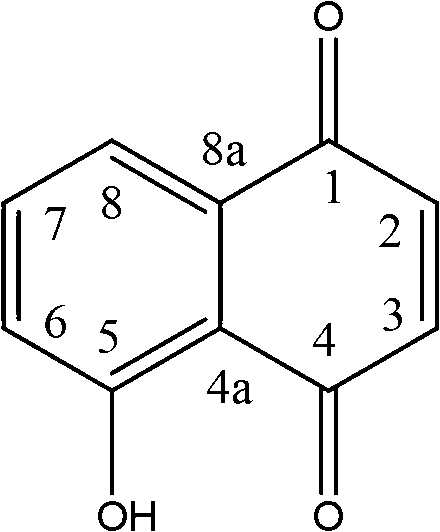Application of juglone to termite control
A technology of juglone and termites, which is applied in the field of application of juglone in termite control, can solve the problems of long residual effect period being eliminated, unsuitable for termite control, high toxicity of aquatic organisms, etc., achieving remarkable control effect, simple structure, and promoting The effect of growth
- Summary
- Abstract
- Description
- Claims
- Application Information
AI Technical Summary
Problems solved by technology
Method used
Image
Examples
Embodiment 1
[0031] The extracts of different plants (extracted with methanol by cold soaking method) were dissolved in methanol to prepare a 1000 μg / mL solution; 1 mL of the drug solution was evenly dropped on the filter paper (diameter = 9 cm) in the petri dish. After the filter paper dries naturally, add 1 mL of distilled water to evenly moisten it, and then put 30 healthy and mature worker ants of Coptotermes formosanus into each dish. All tested petri dishes were cultured in a dark environment with a temperature of 27±1°C and RH=70%±5%. Regularly check and record the death of the tested termites, and replenish water in time according to the wetness of the filter paper. A blank control was set, each treatment was repeated 3 times, and the mortality rate and adjusted mortality rate were calculated according to the following formula.
[0032]
[0033]
[0034] The poisonous effect of different plant extracts on termites was determined by the above method, and the results are shown ...
Embodiment 2
[0041] Determination of poisonous activity: Prepare juglone into a methanol solution of the required concentration, and then use a pipette gun to evenly drop 1mL of the drug solution onto the filter paper (diameter=9cm) in the petri dish. After the filter paper was dried naturally, it was evenly moistened with 1 mL of distilled water. Then put 30 healthy, mature worker ants into each dish. Distilled water was used for control treatments. Each treatment was repeated 3 times, and all tested petri dishes were placed in a dark environment with a temperature of 27 ± 1°C and RH = 70% ± 5%, and the death of the tested termites was checked and recorded at regular intervals. Replenish water in time. Mortality and adjusted mortality were calculated according to the following formula.
[0042]
[0043]
[0044] After the above treatment, the measured results are shown in Table 2.
[0045] Table 2 Toxicity determination of juglone to Coptotermes formosanus
[0046]
[0047] ...
Embodiment 3
[0049] Prepare juglone into a methanol solution of the required concentration, and then use a pipette gun to evenly drop 1mL of the drug solution onto the filter paper (diameter = 9cm) in the petri dish. After the filter paper was dried naturally, it was evenly moistened with 1 mL of distilled water. Then put 30 healthy, mature worker ants into each dish. Distilled water was used for control treatments. Each treatment was repeated 3 times, and all tested petri dishes were placed in a dark environment with a temperature of 27 ± 1°C and RH = 70% ± 5%, and the death of the tested termites was checked and recorded at regular intervals. Replenish water in time. The death and symptoms of termites treated with different concentrations of juglone are shown in Table 3.
[0050] Table 3 Toxicity and symptoms of Coptotermes formosanus treated with different concentrations of juglone
[0051]
[0052] It can be seen from Table 3 that after high concentration (25, 50, 100 μg / mL) jug...
PUM
| Property | Measurement | Unit |
|---|---|---|
| Concentration | aaaaa | aaaaa |
Abstract
Description
Claims
Application Information
 Login to View More
Login to View More - R&D
- Intellectual Property
- Life Sciences
- Materials
- Tech Scout
- Unparalleled Data Quality
- Higher Quality Content
- 60% Fewer Hallucinations
Browse by: Latest US Patents, China's latest patents, Technical Efficacy Thesaurus, Application Domain, Technology Topic, Popular Technical Reports.
© 2025 PatSnap. All rights reserved.Legal|Privacy policy|Modern Slavery Act Transparency Statement|Sitemap|About US| Contact US: help@patsnap.com



